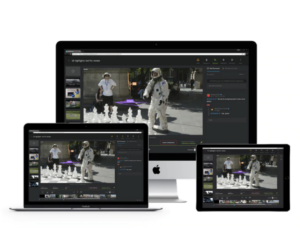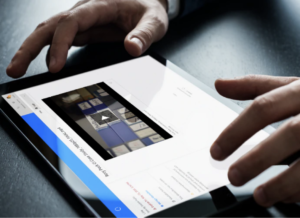HITS

Sony Ci Helps Solve Real-Time WFH Collaboration: CBS News, WGBH, Sony Pictures
Story Highlights
Achieving real-time work-from-home (WFH) collaboration is more important than ever for media and entertainment organizations. Using the Sony Ci cloud-based platform can significantly help accomplish that goal, according to CBS News, Sony and Boston-based Public Broadcasting Service (PBS) station WGBH.
What is coming in especially handy in these days of global, remote WFH is Ci’s real-time LiveSession feature that can be used to seamlessly and securely collaborate on content and continue production operations even when people can’t be in the same room, executives from each of the companies said April 30 during the webinar “How CBS News, WGBH and Sony Pictures Solved Real-Time WFH Collaboration.” Each had a Ci success story to share.
“There have been a lot of challenges with regards to how content moves around and gets created in the last couple of months for sure,” David Rosen, VP of cloud applications and services at Sony Imaging Products and Solutions, Americas, pointed out at the start of the webinar.
 However, CBS News, WGBH and Sony Pictures all “made decisions before two months ago to start moving parts of their workflows into the cloud and, as a result, they were very well-positioned to react quickly to the changes that have recently happened,” he said.
However, CBS News, WGBH and Sony Pictures all “made decisions before two months ago to start moving parts of their workflows into the cloud and, as a result, they were very well-positioned to react quickly to the changes that have recently happened,” he said.
LiveSession has been available in Ci for a long time, but it has “kind of exploded in usage in the last two months,” he said. “We’ve seen a spike in usage,” he said, noting that, as of the prior week, it was up over 650% over two months ago. “People are really finding the benefit of being able to see the same thing at the same time,” he said.
Often, there is an expectation that “disparate” applications that an organization is using, because each one works really well, will be able to “work together in a unified workflow — and they do for the most part,” he pointed out.
“But it takes a lot of work and, over time, what they end up with is a collection of very different applications that have a lot of functional overlap, meaning they’re being used for a lot of the same things,” he noted, adding: “The worst part of it is the content is getting moved from location to location … and so every time you’re moving that content obviously there’s time involved, there’s cost involved, you’re storing that content in multiple places, and there’s security ramifications … . Every place you put that content is one more place that you have to secure. So, there’s certainly some challenges. And that’s really why we created” this unified Ci solution for the networked organization.
“Our intention is to provide a central location where various groups, regardless of what part of the organization or the content lifecycle they’re in, can come to the content and the processing can come to the content as well” — instead of moving the content around from person to person and group to group or app to app, he explained.
 Sony Ci was “built for end-to-end workflows” through post production and then onto distribution and marketing also, he said.
Sony Ci was “built for end-to-end workflows” through post production and then onto distribution and marketing also, he said.
When it comes to remote, real-time collaborative workflows, there are several features that Ci offers that are especially important, including: The ability to search, view and download from anywhere; custom metadata models; accelerated transfers; automated transcoding, artificial intelligence speech to text and computer vision; Live Stream capture; and Cloud Archive, according to the company.
File transfer acceleration is being appreciated by users more than ever now because we tend to have better bandwidth at the office than at home, Rosen said. And “having that file transfer acceleration built in is a huge benefit for sure because I can at least get the most out of my bandwidth” with it when using Ci, he noted.
Three Ci Success Stories
Before remote work was mandatory, CBS News, WGBH and SPE were all early adopters that started using cloud-based solutions to make their production workflows more efficient. At CBS News, post-production teams have embraced the cloud to get to the final cut.
At WGBH, a cloud screening room solution was adopted to reduce cross-continent travel so executive producers could virtually review cuts with the director and editors. At Sony Pictures Entertainment (SPE), productions are given a flexible Workspace in Ci where content can be uploaded, previewed and shared between trusted Workspace members or with external collaborators who only need limited access.
 Tim Mangini, senior director of production technology in the Production Group at WGBH, noted that all the teams within his division have been using Ci for a long time, but the station is using Ci 2-3 times more now than it had been in the past.
Tim Mangini, senior director of production technology in the Production Group at WGBH, noted that all the teams within his division have been using Ci for a long time, but the station is using Ci 2-3 times more now than it had been in the past.
“We have always used it at a number of places in our workflow,” he said, explaining: “We have teams that acquire in the field, they upload to Ci and that way editors can get an early jump on things. Or people who are doing promos can see the material … in a sharable, secure space.”
Ci is also “great for editorial reviews,” Mangini said, noting an editor in New York or London finishes a cut and can then upload a cut for the executive producer to watch, they watch it [and] they send back notes.”
The station recently had to air several episodes of PBS’s long-form news program “Frontline” quickly, after “we had gone to a work-from-home model,” he told listeners. Usually, there are 15-20 people at the WGBH screening room to watch the show, he noted, adding that “in order to mimic that” experience at home “we decided to use the Sony Ci Live feature.”
CBS News, meanwhile, had been “pretty deeply integrated with Ci for a couple of years now, so it made it really easy for us to transition” during the pandemic while working from home, according to Adam Goldfried, its post-production manager.
One feature “that’s been huge” has been the file acceleration, he said, explaining: “Now that our crews really can’t travel that well outside of New York, almost everything that we’re doing in ‘60 Minutes’ and ‘48 Hours’ and a couple of other shows is [with] remote crews… To get the files back [so fast] it’s been invaluable. Just having the easy interface. There’s almost no learning curve. I just onboard somebody and they can use it. That’s been so beneficial.” It also “generates the proxies and it generates them quickly and at such a high quality, you get the distribution … . You get the instant proxies that everybody on the team can screen. So I would say we would have a very hard time at this point dealing with the remote crews if we didn’t have that.”
 SPE has been using Ci since it started, according to Glen Marzan, VP of digital content technologies. Specifically, he noted: “We use it a lot in the VFX world … The videos that we’re uploading are five seconds-10 seconds long … . LiveSession works great for us because of how quickly we can put a team together to do a review.”
SPE has been using Ci since it started, according to Glen Marzan, VP of digital content technologies. Specifically, he noted: “We use it a lot in the VFX world … The videos that we’re uploading are five seconds-10 seconds long … . LiveSession works great for us because of how quickly we can put a team together to do a review.”
In the case of productions the studio is working on now, some people are in London, some in Los Angeles, some in San Francisco and “you can just spin up a session very quickly and start talking about it — so that really helps in the kind of scenarios that we have,” Marzan explained, adding: “Obviously, over the last few months that has picked up. But for us, since we have been using it for quite some time, there was no difference for us. The only difference obviously is people are working from home instead of working from an office. So maybe they’re a little more spread out than before. But the use of the tools hasn’t changed because we’ve been using them for so long. So it was beneficial to be the early adopter of how the entire cloud thing works because now this unforeseen thing has happened [and] for us to switch wasn’t that big of a deal.”
Ci’s “frame accuracy is huge” for VFX people specifically, Marzan went on to say, explaining that visual effects specialists are often “literally looking at” a piece of content a “frame at a time… With that frame accuracy, they can really review that shot pretty well,” he said. Those teams are now using Teams or Zoom video conferencing while doing that and will typically “watch the same shot 50 or 60 times” back and forth from beginning to end — and “every time they’re looking at something different and they’re taking notes along the side, and it’s a very collaborative environment,” he noted.
During the Q&A, Rosen pointed out that while anybody can control video playback during a LiveSession, the ability for the person running that session to block other users from controlling it is “something we’re going to look to add,” based on feedback from some users. Also “on the roadmap” for Ci is the ability to display closed captions, he said.
There is no limit on the number of attendees for a LiveSession, he also noted.
Up to 100 people were tested when Sony was originally building it even though the company didn’t expect anybody would actually use 100 people, he said. However, one organization recently said it wanted all 800 of its employees to participate in a viewing, he noted, adding: “The number of people really shouldn’t impact the streaming quality at all.” However, it’s questionable what the interactivity will look like if all 800 people are making annotations during a session, he conceded.









